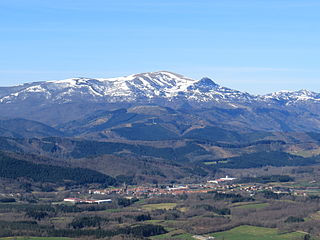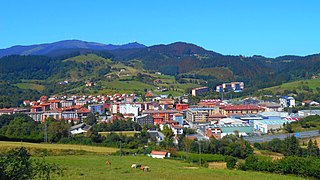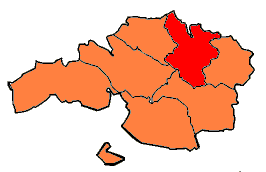
Amorebieta-Etxano, also known as Zornotza, is a town and municipality located in Biscay in the Basque Country, an Autonomous Community in northern Spain.

Karrantza Harana/Valle de Carranza, is a town and municipality located in the province of Biscay, in the Basque Country. It is located in the comarca of Enkarterri and it is the westernmost and largest municipality of the province.

Ajangiz is a town and municipality in the province of Biscay, in the Basque Country. It is located in the Busturialdea comarca, and was part of the municipality of Gernika-Lumo between 1940 and 1991.
Arrieta is a town and municipality located in the province of Biscay, in the Basque Country, Spain. Arrieta is part of the comarca of Mungialdea. It had a population of 552 inhabitants as of 2007, and a population of 564 inhabitants as of 2017.

Atxondo is a municipality located in the province of Biscay, in the Basque Country, Spain. Atxondo is part of the comarca of Durangaldea and has a population of 1,447 inhabitants as of 2007 according to the Spanish National Statistics Institute.

Berriz is an elizate, town and municipality located in the province of Biscay, in the Basque Country, northern Spain. Berriz is part of the comarca of Durangaldea and has a population of 4.623 inhabitants as of 2019 and according to the Spanish National Statistics Institute.

Elorrio is a town and a municipality located in the eastern part of the province of Biscay, in the Basque Country, in northern Spain. As of 2017, it has a population of 7,307 inhabitants. It covers an area of 37.20 square kilometers and it has a population density of 193.58 people per square kilometer. It holds the medieval title of Most Loyal and Noble Villa.

Ermua is a town and municipality located in the province of Biscay, in the autonomous community of Basque Country, northern Spain. In 2019, Ermua had 15,880 inhabitants.

Izurtza is an elizate, town and municipality located in the province of Biscay, in the Basque Country, Spain. Izurtza is part of the comarca of Durangaldea and has a population of 270 inhabitants as of 2010 and according to the Spanish National Statistics Institute.

Mallabia is an elizate, town and municipality located in the province of Biscay, in the Basque Country, northern Spain. Mallabia is part of the comarca of Durangaldea and has a population of 1.135 inhabitants as of 2006 and according to the Spanish National Statistics Institute.

Mañaria is an elizate, town and municipality located in the province of Biscay, in the Basque Country, Spain. Mañaria is part of the comarca of Durangaldea and has a population of 459 inhabitants as of 2006 according to the Spanish National Statistics Institute.

Otxandio is a town and municipality located in the province of Biscay, in the Basque autonomous community, Spain. Otxandio is part of the comarca of Durangaldea and has a population of 1,269 inhabitants as of 2010 according to the Spanish National Statistics Institute.

Zaldibar is an elizate, town and municipality located in the province of Biscay, in the Basque Country, Spain. Zaldibar is part of the comarca of Durangaldea and has a population of 3,043 inhabitants as of 2019 and according to the Spanish National Statistics Institute.
Greater Bilbao is an administrative division of the province of Biscay, in the Basque Country, Spain. It is one of the seven comarcas of Biscay and the most populated one. The capital city of Greater Bilbao is Bilbao.

Busturialdea, also named Busturialde - Urdaibai is a comarca of the province of Biscay, in the Basque Country, Spain. It is the heir of "Busturia", one of the original merindades that used to compose the province of Biscay – this should not be confused with Busturia, a municipality located in this region. Busturialdea is a diminished portion of the same original subregion and has two capital cities; Bermeo and Gernika-Lumo. It is one of the seven comarcas that compose the province of Biscay.

Durangaldea is a comarca of Biscay located in the Basque Country, Spain. It is one of the seven eskualdeak/comarcas or regions that compose the province of Biscay. The capital city of Durangaldea is Durango.

The Lordship of Biscay was a region under feudal rule in the region of Biscay in the Iberian Peninsula between c.1040 and 1876, ruled by a political figure known as the Lord of Biscay. One of the Basque señoríos, it was a territory with its own political organization, with its own naval ensign, consulate in Bruges and customs offices in Balmaseda and Urduña, from the 11th century until 1876, when the Juntas Generales were abolished. Since 1379, when John I of Castile became the Lord of Biscay, the lordship was integrated into the Crown of Castile, and eventually the Kingdom of Spain.

Arratia-Nerbioi is a comarca of the province of Biscay, in the Basque Country, Spain. It is formed by the valleys of the Arratia river and the Nervión river. It is one of the seven eskualdeak or comarcas that compose the province of Biscay.

The autonomous community of the Basque Country within Spain contains several comarcas or eskualdeak in the Basque language, referring to local districts, grouped into its three long-established provinces.

The County of Durango, also known as Land of Durango and Merindad of Durango, was the ancient political administration of the territory that is now known as Durangaldea, in the Basque region of Biscay. This political administration included all the towns and elizates that existed within its territory. The elizates were all governed by the Foral law, while the towns had their own law. The county of Durango was a vassal state of the Kingdom of Pamplona, and in the 13th century it became a constituent part of the Lordship of Biscay. It has been part of the territory of Biscay since then. Its capital city was the town of Durango.






















